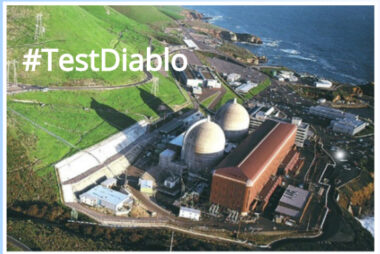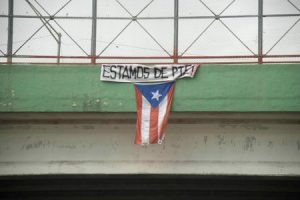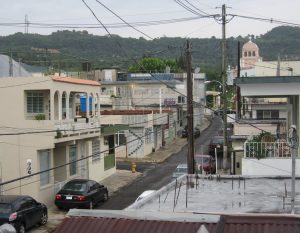Governor Newsom: Let’s Check Diablo Canyon Closely
Diablo’s on shakey ground[/caption] Dear Governor Newsom, We welcome you as our governor.… We ask that critical safety tests be performed at Diablo Canyon Nuclear Unit One during the refueling outage that will begin on or about February 3. This shutdown provides the perfect opportunity to examine the facility without unduly halting operations. We do not ask at this point that the reactor be permanently closed – only that it be tested to see if it is safe to restart. Before Unit One is reloaded with nuclear fuel, the key evaluations must be finished and subjected to public hearings. The final decision as to whether to reload Unit One with fuel or restart it must be made by the state in conjunction with the bankruptcy court. As you know, after meeting with CPUC, local community and environmental groups, unions, and state officials, PG&E agreed to not seek license renewals for Units One & Two in 2024-2025, thus guaranteeing the plant will shut in six years. In the course of this negotiation PG&E admitted that renewables could replace Diablo’s capacity. Here are several key issues that arise with this refueling outage:
- EMBRITTLEMENT: In 2005 the Nuclear Regulatory Commission warned that Diablo Unit One was among the five most embrittled reactors in the US. The intense heat, pressure, and radiation in a nuclear reactor can cause critical metals and welds in the pressure vessels to lose their resiliency should cold water be poured in to contain a runaway reaction, embrittled components can shatter, leading to catastrophe. Using “coupons” (bits of metal inserted into key parts of the reactor for precisely this testing purpose) for destructive analysis, the degree of embrittlement at Unit One can be easily and cheaply tested while it is down for refueling. Unit One was built with an inordinate amount of copper, which may make it particularly vulnerable to embrittlement. The test results must be made public and subjected to a public hearing.
- COMPONENT CRACKING: Heat, pressure and radiation can also cause cracks in a pressure vessel and other key components. Given Unit One’s age, an inspection is imperative. Ultra-sound devices can be cheaply and easily deployed to look for cracks while the reactor is shut. Again, the findings must be made public and subjected to open hearings.
- DEFERRED MAINTENANCE: Since perhaps as early as 2010, PG&E has deferred repairs and component replacements on the assumption that Diablo would close when its license expires in 2025. The state, bankruptcy court, and public must see exactly what PG&E has not done and does not plan to do in the six years remaining on its license.
- WASTE MANAGEMENT: It appears PG&E plans to store Diablo’s extremely radioactive spent fuel waste in Holtec casks that are less than one inch thick. (By contrast, Germany stores its spent fuel assemblies in casks that are 19 inches thick). Cracking and mishandling of dry casks, issues that have arisen at other nuclear sites including San Onofre, make it essential to fully evaluate waste management at Diablo. This, in particular, demands public scrutiny.
- SEISMIC VULNERABILITY: Since Unit One was designed, a dozen earthquake faults have been discovered surrounding Diablo. NRC site inspector Dr. Michael Peck, in residence at Diablo for five years, warned the reactors might not withstand a credible quake. The Nuclear Regulatory Commission buried Dr. Peck’s initial memo and transferred him to Tennessee, but he has written publicly about his concerns. The distance from Diablo to the San Andreas fault is half the distance from Fukushima to the epicenter of the quake that destroyed it. Dr. Peck (who has left the NRC) must be publicly debriefed and the seismic issues at Diablo subjected to an open hearing before Unit One is reloaded.
- USEFUL? At this point California is awash in electric power supply and probably does not need Diablo’s capacity. Nor is it likely the electricity produced at Diablo can economically compete with the onrush of renewables. In fact, PG&E has admitted that all Diablo’s power can be replaced by available renewables. Furthermore, because it cannot easily shut off and restart its power to meet fluctuating demand, Diablo’s presence on the grid can be a burden, resulting in the temporary shutdown of cheaper renewable facilities.


 A flag hangs from a highway overpass in Caguas, Puerto Rico declaring “Estamos de pie,” or “We are standing.” October, 2017.
A flag hangs from a highway overpass in Caguas, Puerto Rico declaring “Estamos de pie,” or “We are standing.” October, 2017.

Hollywood Stars, Grassroots Activists, State Senator, Mayor & Major Organizations Ask Gov. Newsom to Fully Inspect Aged Diablo Canyon Nuclear Unit One Before it Re-Fuels
Hollywood Stars, Grassroots Activists, State Senator, Mayor & Major Organizations
Ask Gov. Newsom to Fully Inspect Aged Diablo Canyon Nuclear Unit One Before it Re-Fuels
Contact: Mimi Kennedy (315) 246-7333; Harvey Wasserman (614) 738-3646 – solartopia@gmail.com; Myla Reson (310) 663-7660 – myla.reson@gmail.com
Dear Gov. Newsom,
We join hundreds of other Californians, including Sen. Ben Allen and San Luis Obispo Mayor Heidi Harmon, who are calling, writing, faxing and e-mailing, asking that you take action at Diablo Canyon to protect our safety and economic future. Under PG&E’s current bankruptcy and criminal proceedings, your position gives you wide ranging powers to act.
Diablo Unit One is now shut for refueling. We feel that given the evidence of embrittlement, it is very important to halt the loading of new fuel into the reactor until the public resolution of seven critical issues:
We ask that BEFORE DIABLO ONE REFUELS you subject these and other critical issues to open public scrutiny. The decision on Diablo’s future must be made by you in conjunction with the Legislature, the CPUC, state agencies, the courts and the public.
We thank you very much for giving this your serious consideration. We feel this is an exciting and crucial opportunity for you to continue your groundbreaking leadership in bringing more safety, responsibility, and wise energy policy to all Californians. Let us keep showing the way to a safer (and more sustainable) energy future.
– – – –
Signatories (partial list):
Mimi Kennedy
Jane Fonda
Jodie Evans, CODEPINK
Frances Fisher
Lila Garrett
Dr. Helen Caldicott
Dianna Cohen, CEO & Co-Founder, Plastic Pollution Coalition
Susan Clark
Barbara Williams
Ed Asner
Graham Nash
Eric Roberts
Martin & Janet Sheen
Keaton & Eliza Simon
Ed Begley, Jr.
Lance Simmens
John Densmore, Drummer for the Doors
Dana Gluckstein, Chair People for A Safe Future
David Krieger, President Nuclear Age Peace Foundation (NAPF)
Sara Nichols
Nancy Stevens
Alan Weissman
Pamela Conley Ulich, former Malibu Mayor
Roger Pugliese
Tony Dow
David Braun
Dr. Peter Alsop
Alan Minsky, PDA
– – –
Separate petitions, resolutions & other supporting letters & documents are from:
Topanga Town Council
San Luis Obispo Mothers for Peace
Americans for Democratic Action (Los Angeles)
Progressive Democrats of the Santa Monica Mountains
Pacific Palisades Democratic Club
Santa Monica Democratic Club Executive Board
The Officers of the Progressive Caucus of the California Democratic Party
The Los Angeles County Democratic Party
Culver City Democratic Club
People Demanding Action Campaign:
Reach: 60,000
1,725 Letters Sent
85 phone calls
Facebook Ad Campaign:
Reach: 108,000
Impressions: 115,680
Video Views: 56,101
Join Us at MoveOn.org: 4,372; signees: 1,017
Twitter campaign: #TestDiablo
Diablo Canyon Nuclear Power Plant